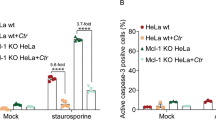Abstract
Chlamydiae are obligate intracellular bacteria that cause variety of human diseases. Chlamydia-infected host cells are profoundly resistant to apoptosis induced by many different apoptotic stimuli. The inhibition of apoptosis is thought to be an important immune escape mechanism allowing chlamydiae to productively complete their obligate intracellular growth cycle. Infection with chlamydiae can activate the Raf/MEK/ERK pathway. Because the survival pathway can modulate apoptosis, we used MEK-specific inhibitor U0126 and Raf-specific inhibitor GW5074 to examine the role of Raf/MEK/ERK pathway in chlamydial antiapoptotic activity. Apoptosis was induced by staurosporine (STS) and detected by morphology, DNA fragmentation, caspase-3 activation, and poly (ADP-ribose) polymerase cleavage. Inhibition of the pathway sensitized Chlamydia-infected cells to STS-mediated cell apoptosis. The data indicate that chlamydial antiapoptotic activity involves activation of the Raf/MEK/ERK survival pathway.





Similar content being viewed by others
References
Bea F, Puolakkainen MH, McMillen T et al (2003) Chlamydia pneumoniae induces tissue factor expression in mouse macrophages via activation of Egr-1 and the MEK-ERK1/2 pathway. Circ Res 92:394–401
Carabeo RA, Mead DJ, Hackstadt T (2003) Golgi-dependent transport of cholesterol to the Chlamydia trachomatis inclusion. PNAS 100:6771–6776
Dong F, Pirbhai M, Xiao Y et al (2005) Degradation of the proapoptotic protein Bik, Puma, and Bim with Bcl-2 domain 3 homology in Chlamydia trachomatis-infection cells. Infect immun 73:1861–1864
Fan T, Lu H, Hu H et al (1998) Inhibition of apoptosis in Chlamydia-infected cells: blockade of mitochondrial cytochrome c release and caspase activation. J Exp Med 187:487–496
Fischer SF, Vier J, Kirschnek S et al (2004) Chlamydia inhibit host cell apoptosis by degradation of proapoptotic BH3-only protein. J Exp Med 200:905–916
Hackstadt T, Rockey DD, Heinzen RA et al (1996) Chlamydia trachomatis interrupts an exocytic pathway to acquire endogenously synthesized sphingomyelin in transit from the Golgi apparatus to the plasma membrane. EMBO J 15:964–977
Henkart PA (1996) ICE family proteases: mediators of all apoptotic cell death? Immunity 4:195–201
Hess S, Rheinheimer C, Tidow F et al (2001) Chlamydia trachomatis-induced up-regulation of glycoprotein 130 cytokines, transcription factors, and antiapoptotic genes. Arthritis Rheum 44:2392–2401
Kaplan DR, Miller FD (2000) Neurotrophin signal transduction in the nervous system. Curr Opin Neurobiol 10:381–391
Kerr JF, Wyllie AH, Currie AR (1972) Apoptosis: a basic biological phenomenon with wide-ranging implications in tissue kinetics. Br J Cancer 26:239–257
Kyriakis JM, Avruch J (1996) Sounding the alarm: protein kinase cascades activated by stress and inflammation. J Biol Chem 271:24313–24316
Lockshin RA (2005) Programmed cell death: history and future of a concept. J Soc Biol 199:169–173
Nicholson DW, Thornberry NA (1997) Caspases: killer proteases. Trends Biochem Sci 22:299–306
Perkins D, Pereira EF, Aurelian L (2003) The herpes simplex virus type 2 R1 protein kinase (ICP10 PK) functions as a dominant regulator of apoptosis in hippocampal neurons involving activation of the ERK survival pathway and upregulation of the antiapoptotic protein Bag-1. J Virol 77:1292–1305
Perkins D, Pereira EF, Gober M et al (2002) The herpes simplex virus type 2 R1 protein kinase (ICP10 PK) blocks apoptosis in hippocampal neurons, involving activation of the MEK/MAPK survival pathway. J Virol 76:1435–1449
Rajalingam K, Sharma M, Lohmann C (2008) Mcl-1 is a key regulator of apoptosis resistance in Chlamydia trachomatis-infected cells. PLoS One 3(9):e3102
Salvesen GS, Dixit VM (1997) Caspases: intracellular signaling by proteolysis. Cell 91:443–446
Su H, McClarty G, Dong F et al (2004) Activation of Raf/MEK/ERK/cPLA2 signaling pathway is essential for Chlamydial acquisition of host glycerophospholipids. J Biol Chem 279:9409–9416
Thornberry NA, Lazebnik Y (1998) Caspases: enemies within. Science 281:1312–1316
Tran SE, Holmstrom TH, Ahonen M et al (2001) Mitogen-activated protein kinase/ERK overrides the apoptotic signaling from Fas, tumor necrosis factor alpha, and TRAIL receptors. J Biol Chem 276:16484–16490
Webb SJ, Harrison DJ, Wyllie AH (1997) Apoptosis: an overview of the process and its relevance in disease. Adv Pharmacol 41:1–31
Wyllie AH, Kerr JF, Currie AR (1980) Cell death: the significance of apoptosis. Int Rev Cytol 68:251–306
Xia M, Bumgarner RE, Lampe MF et al (2003) Chlamydia trachomatis infection alters host cell transcription in diverse cellular pathways. J Infect Dis 187:424–434
Xiao Y, Zhong Y, Greene W et al (2004) Chlamydia trachomatis infection inhibits both Bax and Bak activation induced by staurosporine. Infect immun 72:5470–5474
Yan CY, Greene LA (1998) Prevention of PC12 cell death by N-acetylcysteine requires activation of the Ras pathway. J Neurosci 18:4042–4049
Ying S, Seiffert BM, Hacker G et al (2005) Broad degradation of proapoptotic proteins with the conserved bcl-2 homology domain 3 during infection with Chlamydia trachomatis. Infect immun 73:1399–1403
Zhong G, Fan P, Ji H et al (2001) Identification of a chlamydial protease-like activity factor responsible for the degradation of host transcription factor. J Exp Med 193:935–942
Author information
Authors and Affiliations
Corresponding author
Rights and permissions
About this article
Cite this article
Du, K., Zheng, Q., Zhou, M. et al. Chlamydial Antiapoptotic Activity Involves Activation of the Raf/MEK/ERK Survival Pathway. Curr Microbiol 63, 341 (2011). https://doi.org/10.1007/s00284-011-9985-2
Received:
Accepted:
Published:
DOI: https://doi.org/10.1007/s00284-011-9985-2




